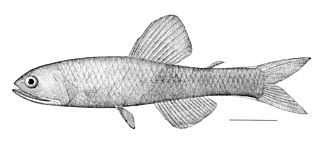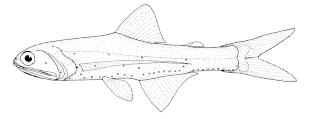
Lampanyctus is a genus of lanternfishes.

The southern lanternfish, Lampanyctus australis, is a lanternfish of the family Myctophidae, found circumglobally in the southern hemisphere between 33° S and 44° S, mainly at below 500 m. Its length is about 13 cm. It is an oceanic mesopelagic species, eaten by hakes, kingklip and Cape horse mackerel.

Banksia nobilis, commonly known as the golden dryandra, great dryandra or kerosene bush, is a shrub of the family Proteaceae which is endemic to Western Australia. It occurs on lateritic rises from Eneabba to Katanning in the state's Southwest Botanic Province. With large pinnatifid leaves with triangular lobes, and a golden or reddish pink inflorescence, it is a popular garden plant. It was known as Dryandra nobilis until 2007, when all Dryandra species were transferred to Banksia by Austin Mast and Kevin Thiele. There are two subspecies, B. nobilis subsp. nobilis and B. nobilis subsp. fragrans.
Banksia nobilis subsp. nobilis is a subspecies of Banksia nobilis. As an autonym, it is defined as encompassing the type material of the species. It was known as Dryandra nobilis subsp. nobilis until 2007, when Austin Mast and Kevin Thiele transferred Dryandra into Banksia. As with other members of Banksia ser. Dryandra, it is endemic to the South West Botanical Province of Western Australia.
Lampanyctus acanthurus is a species of lanternfish.

Lampanyctus alatus is a species of lanternfish. It is found in parts of the Atlantic, Indian, and Pacific Oceans. It grows to 6.1 cm (2.4 in) standard length.
Lampanyctus festivus is a species of lanternfish. It is found in the Atlantic, Indian, and Pacific Oceans. It is a mesopelagic fish that undertakes diel vertical migration. It grows to about 14 cm (5.5 in) standard length. It is an important component in the diet of forkbeard Phycis phycis off the Azores.
Lampanyctus hubbsi is a species of lanternfish.
Lampanyctus intricarius is a species of lanternfish.
Lampanyctus iselinoides is a species of lanternfish.
Lampanyctus jordani is a species of lanternfish.
Lampanyctus lepidolychnus is a species of lanternfish.

Lampanyctus macdonaldi is a species of lanternfish.
Lampanyctus macropterus is a species of lanternfish.
Lampanyctus photonotus is a species of lanternfish.
Lampanyctus pusillus is a species of lanternfish.
Lampanyctus simulator is a species of lanternfish.
Lampanyctus steinbecki is a species of lanternfish.
Lampanyctus turneri is a species of lanternfish. It is found in the Indian and western Pacific Oceans. It grows to 7 cm (2.8 in) standard length.
Lampanyctus vadulus is a species of lanternfish.



